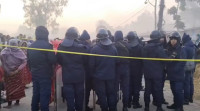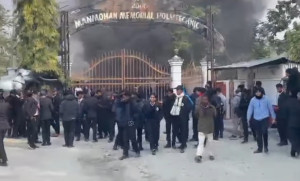Koshi Province
People in Khotang say their elected leaders lack vision and waste budget in inconsequential projects
Local units across the district are concentrating on projects that have no positive impacts on people's living standard.Dambar Singh Rai
For locals in Jalapa village, in Khotang, the major source of sustenance is the production of food crops like paddy, maize, and millet, along with animal husbandry. However, even when their produce hits surplus, the farmers have no means or method of monetising their yield.
Jalapa is a village that seems to be stuck in time. When animals contract diseases, often farmers are left with no option but to let them have a quiet death. Crops that are infected with even the least harmful of pests wither away.
The few veterinarians and agro-technicians who visit far-flung villages in the district are not enough, informs Min Bahadur Budhathoki, agriculture coordinator of Rupakot Majhuwagadhi Municipality. “Five veterinarians and seven agro-technicians cover 15 far-flung wards. One technician has to reach more than two wards on one visit,” said Budhathoki.
And problems are not limited to farming in Jalapa, in fact they are more severe when it comes to developmental infrastructure, say locals.
Shiromani Rai, 50, for instance, died because the villagers couldn’t take him to the hospital on time due to a lack of road access, said Devendra Rai, a local. Shiromani had fainted with a sudden rise in blood pressure. The villagers tried to take him to the headquarters, Diktel, but the muddy road was blocked in Khoralu. “There was no other option to take him to the hospital other than to chart a helicopter,” said Devendra, “which we could not afford.”
Locals the Post talked to lamented that local units across Khotang district concentrate on projects that do not focus on the upliftment of their way of living.
Dhruba Shrestha, a local, cited that there are about half-a-dozen projects in the area that do not have actual benefits for the locals, such as Aankha Pokhari construction project in Mahure; Buipa’s Yalamber Park; Pen Tower of Bagare Bhanjyang, and so on. “These projects are supposed to attract tourists, and a significant chunk of the development budget from the local units has gone into constructing them,” said Shrestha. “It would be more productive for locals if the local units invest on productive, impactful projects.”
Even though almost all the wards of the municipality are connected with road network, they are used more to import than to export produce from the villages, say locals. This has also affected the local economy, said Khusnarayan Sainju, chair of Nepal Chamber of Commerce, Khotang. “It would be good if we can export products such as bitter gourds and potatoes that are grown in abundance in villages in Khotang,” Sainju said. “But the municipality doesn’t have a vision, and because of this, the local economy is struggling.”
But it’s not only the locals that are dissatisfied with the municipality’s approach to development. Many ward chairs have also been vocal about the allocation of budget. “We didn’t get enough funding to run any productive project,” said Mugadhan Rai, chairman of Ward No. 10.
“Development doesn’t mean only infrastructure development,” said Bhim Rai, chairman of Ward No. 13. “It should also be a development in the way of living.”




 16.57°C Kathmandu
16.57°C Kathmandu














